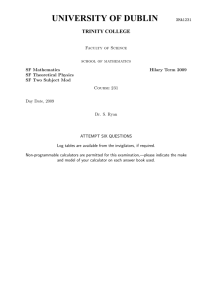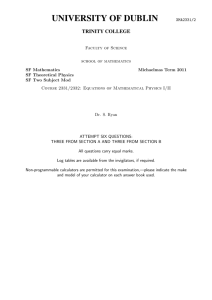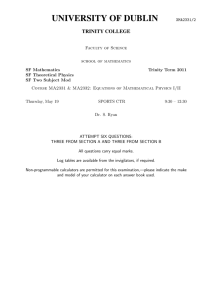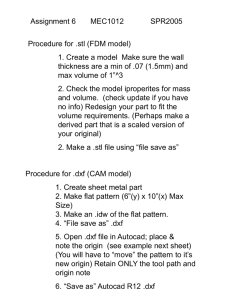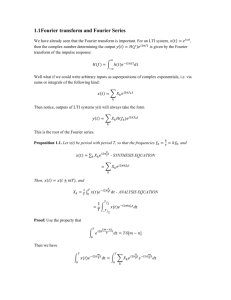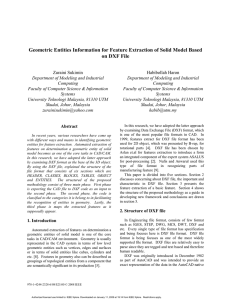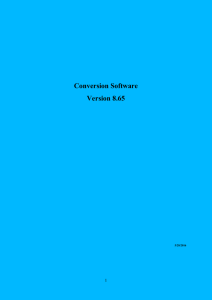UNIVERSITY OF DUBLIN TRINITY COLLEGE
advertisement
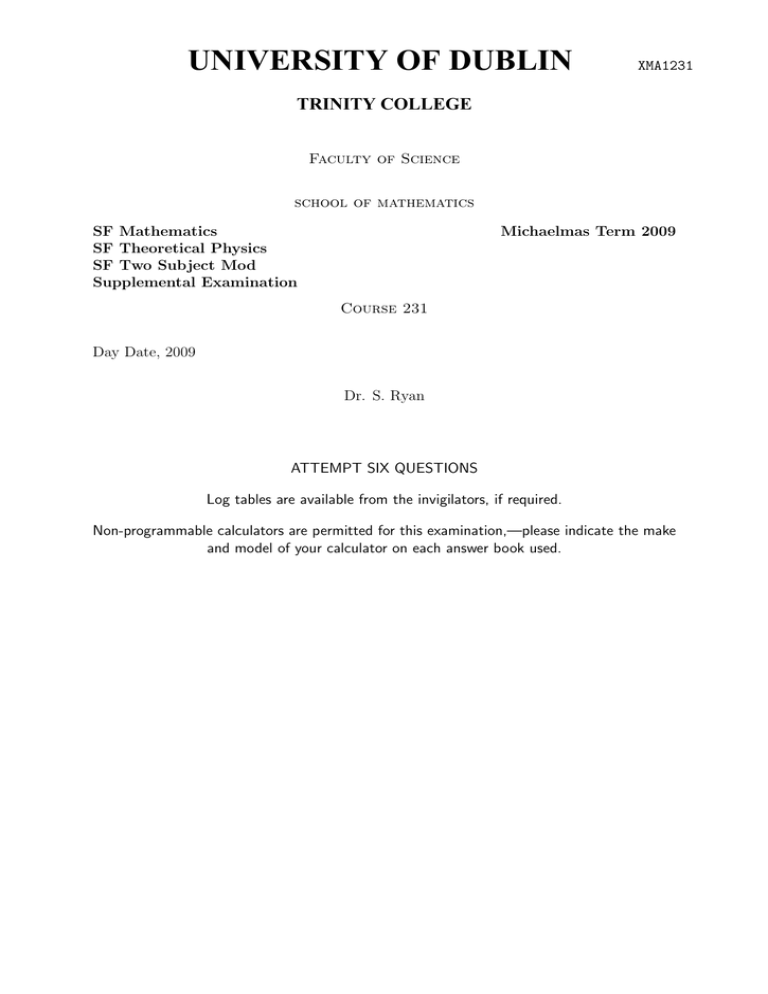
UNIVERSITY OF DUBLIN XMA1231 TRINITY COLLEGE Faculty of Science school of mathematics SF Mathematics SF Theoretical Physics SF Two Subject Mod Supplemental Examination Michaelmas Term 2009 Course 231 Day Date, 2009 Dr. S. Ryan ATTEMPT SIX QUESTIONS Log tables are available from the invigilators, if required. Non-programmable calculators are permitted for this examination,—please indicate the make and model of your calculator on each answer book used. 2 XMA1231 1. In two dimensions, write down the change of variables from Cartesian to polar coordinates. Calculate the appropriate Jacobian for this transformation. Consider the half-disk, x2 + y 2 ≤ 1 and x > 0 enclosing a region, D of the xy-plane. Sketch this region and evaluate its area. The centres of mass are defined as R R dAρ(x, y)y dAρ(x, y)x D , ȳ = RD . x̄ = R dAρ(x, y) dAρ(x, y) D D where ρ(x, y) is the density. For uniform density ie. ρ(x, y) = 1 determine the centres of mass. 2. Show that if a continuous vector field F in an open and connected domain D is conservative then it is path-independent. Compute the following line integrals. I (a) F · dl where C is the unit circle in the xy-plane, taken anticlockwise and C F = xi + yj. I (b) F · dl where C is again the unit circle in the xy-plane, taken anticlockwise C and F = yi − x2 yj. Z (c) F · dl where C is the unit circle in the first quadrant ie x2 + y 2 = 1, x ≥ C 0, y ≥ 0, taken anticlockwise and F = xj. 3. Consider the function f (x) = x2 , periodic on the interval [−π, π]. Determine the (real) Fourier series for f (x). Use this result and Parseval’s identity to determine the following closed-form expression for the Riemann zeta function at s = 4, namely that π4 ζ(4) = , 90 noting that ∞ X 1 ζ(s) = , (s > 1). ns n=1 4. Given a function, Φ(x, y) which is harmonic in the square described by 0 ≤ x ≤ π and 0 ≤ y ≤ π. Suppose that Φ is zero on three sides of this square (ie Φ(0, y) = Φ(π, y) = Φ(x, π) = 0) and on the lower side Φ(x, 0) = sin(x). Determine Φ(x, y) within the square. 3 XMA1231 5. State Stokes’ theorem. R Use Stokes’ theorem to evaluate S (∇ × F) · dS where the vector field F = z 2 i − 3xyj + x3 y 3 k and S is the surface described by z = 5 − x2 − y 2 above the z = 1 plane and oriented upwards. Explain why Stokes theorem cannot by used to transform the surface (flux) integral Z (xi + yj + zk) · dS S into a line integral on the boundary of S. 6. Prove that the Fourier transform of an even function is even. Compute the Fourier transform of f (x) = e−a|x| where a is a positive constant. Use the result to show that Z ∞ −∞ π cos(p) = . 2 1+p e 7. Using the Frobenius method find a series solution of the ODE, x(x − 1)y 00 (x) + 3xy 0 (x) + y(x) = 0, where as usual the prime denotes differentiation with respect to x. Comment on the behaviour of the second solution determined from the Frobenius method. Suggest a method to construct the second solution. 8. Prove that Z ∞ (a) dxδ 0 (x)f (x) = −f 0 (0). −∞ Z ∞ (b) dxδ(h(x))f (x) = −∞ n X f (xi ) , where xi are the roots of the continuous 0 (x )| |h i i=1 function h(x). Compute Z ∞ (i) dxδ(x2 − x − 2). −∞ 1 Z (ii) dxδ(sin(1/x)). 0 (iii) d aθ(x) e where a is a constant and θ(x) is the Heaviside function (see page of dx useful formulae). 4 1 XMA1231 Some useful formulae 1. A function with period l has a Fourier series expansion ∞ a0 X f (x) = + an cos 2 n=1 2πnx l + ∞ X bn sin n=1 2πnx l where a0 an bn l/2 Z 2 = l dxf (x), −l/2 l/2 2πnx , dxf (x) cos l −l/2 Z 2 l/2 2πnx = . dxf (x) sin l −l/2 l Z 2 = l 2. A function with period l has a Fourier series expansion f (x) = ∞ X cn exp n=−∞ where 1 cn = l Z l/2 2iπnx l dxf (x) exp −l/2 , −2iπnx l . 3. The Fourier integral representation (or Fourier transform) is Z ∞ f (x) = dk fg (k)eikx , −∞ Z ∞ 1 g f (k) = dxf (x)e−ikx . 2π −∞ 4. The Dirac delta function: Z ∞ dxf (x)δ(x) = f (0). −∞ 5. The Heaviside function θ(x) is θ(x) = 1, x ≥ 0 0, x < 0 . c UNIVERSITY OF DUBLIN 2009 ,
